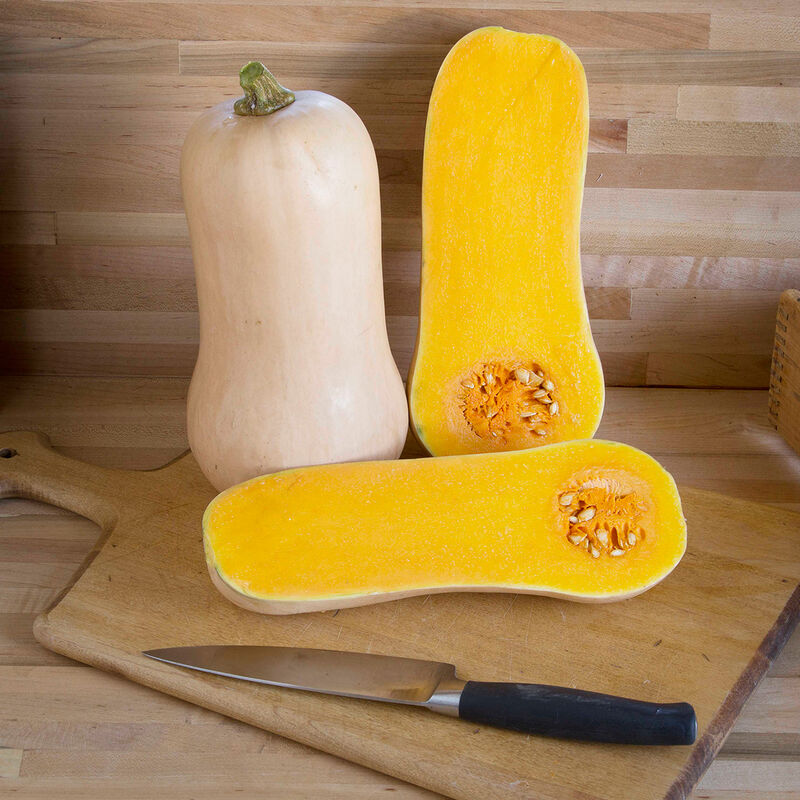Waldo PMR Organic (F1) Butternut Squash Seed
Waldo PMR Organic (F1) Butternut Squash Seed
Great flavor in a larger market size.
One of our best-tasting Johnny's-bred butternuts! Produces big yields with very few culls. Better than similar market hybrids. Great, marketable size—in between JWS 6823 and Waltham Butternut—large enough for a few servings, but not so big it goes to waste. A smaller, improved Waltham: more uniform and attractive without the oversized fruits. Vigorous plants and strong PMR ensure crops reach maturity under high disease pressure. Long vines. Good storage life. Our thanks to Cornell University for their help in developing this variety. Avg. weight: 4–5 lb. USDA Certified Organic.Disease Resistance:
Specs:
- This product does not ship to the following countries: Australia, Japan, Republic of Korea, New Zealand, Taiwan.
SCIENTIFIC NAME:
Cucurbita moschataCULTURE:
Fertile, well-drained soil with a pH of 6.0–6.8 is best. Plastic mulch and fabric row covers (AG-19 grade) can aide plant establishment and exclude insect pests during the seedling stage. Row covers should be removed when plants begin to flower to allow for pollination. Poor fruit development may indicate insufficient pollination.TRANSPLANTING:
Sow 2-3 seeds per 2" container or plug flat about 3 weeks prior to transplanting. Thin to 1 plant/container or cell with scissors. Harden plants 4–7 days prior to transplanting. After danger of frost has passed, transplant out according to the spacing recommendations for each variety. Handle seedlings carefully; minimal root disturbance is best.DIRECT SEEDING:
Sow 2 seeds at the appropriate spacing interval for the variety's vine length, 1/2-1" deep. Thin to 1 plant per spacing interval after seedlings are established.PLANT SPACING:
Bush to short-vine habits generally require 6' between-row spacing, while long-vine habits require 12' between-row spacing. In-row spacing depends on fruit size as well as vine length and is generally: small fruit/bush or short vine type: 18-24"; medium fruit and vine length: 24-36"; large fruit or long vine length: 36-48". Butterscotch PMR will produce smaller, 1-lb, "single-serving-size" fruits when grown at 6 sq.ft. per plant.DISEASES:
Common cucurbit diseases include powdery mildew, downy mildew, bacterial wilt, and Phytophthora. Avoid problems by ensuring adequate soil drainage, good air flow, insect pest control, and crop rotation. If necessary, check with your local Cooperative Extension Service agent for specific control options.INSECT PESTS:
Cucumber beetles, squash bugs, and vine borers are all common pests for cucurbits. Protect young plants with floating row cover. Squash bug eggs found on the undersides of leaves may be crushed by hand. For vine borers, cut out of vines and hill soil over the wound. Keep field borders mowed and remove plant refuse in the fall; spring plow to bury pupae. C. moschata types are less susceptible to vine borers. Pyrethrin sprays may offer some control.HARVEST:
Fruits are typically ready about 50-55 days after fruit set, and should be harvested before any hard frosts. Cut fruits from vines and handle carefully. Sun cure by exposing fruits for 5-7 days or cure indoors by keeping squash at 80-85°F/27-29°C and 80-85% relative humidity (RH) with good air ventilation.STORAGE:
Store at 50-55°F/10-13°C, 50-75% RH and good ventilation. Repeated exposure to temperatures below 50°F/10°C may cause chilling damage. Different types of squash have different storage times and optimal eating periods. Refer to our Winter Squash Curing & Storage Chart for more detailed information.DAYS TO MATURITY:
From direct seeding; subtract about 14 days if transplanting.AVG. DIRECT SEEDING RATES:
(At 2 seeds/ft., rows 6' apart.) 1 oz./155', 1 lb./2,500', 3 lb./acre.SEED SPECS:
See individual varieties.PACKET:
30 seeds.Johnny's is committed to your success, every step of the way.
We want you, our customer, to be 100% satisfied with all of our seeds, tools, and supplies.
If anything you purchase from us proves unsatisfactory, we will either replace the item or refund the purchase price.






